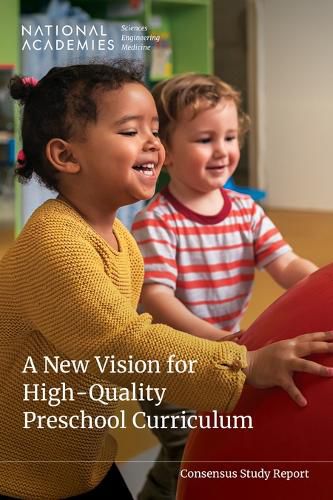Readings Newsletter
Become a Readings Member to make your shopping experience even easier.
Sign in or sign up for free!






A high-quality preschool education can foster critical development and learning that promotes joyful, affirming, and enriching learning opportunities that prepare children for success in school and life. While preschool programs generally provide emotionally supportive environments, their curricula often fall short in advancing learning in math, early literacy, and science, and lack the necessary support for multilingual learners emerging bilingualism. Additionally, access to high-quality, effective early learning experiences may be limited and inadequate based on factors such as a childs race, location, gender, language, identified disability, and socioeconomic status.
A New Vision for High-Quality Preschool Curriculum examines preschool curriculum quality for children from ages three to five, with special attention to the needs of Black and Latine children, multilingual learners, children with disabilities and children experiencing poverty in the United States. The report articulates a vision for high-quality preschool curricula for all children, grounded in an equity and justice-oriented principles from inception to implementation and evaluation.
Table of Contents
Front Matter Summary 1 Introduction 2 Evidence on the Effectiveness of Preschool Curricula 3 The Science of Early Learning and Brain Development 4 Developing High-Quality, Equitable Preschool Curricula 5 Optimizing the Learning Environment for Effective and Equitable Curriculum Delivery 6 Specialized and Targeted Curricula and Practices for Supporting Children with Disabilities 7 High-Quality Early Childhood Curriculum for Multilingual Learners 8 State- and Program-Level Curriculum Decision Making and Selection 9 Examining Variation in Curriculum Effects 10 Conclusions, Recommendations, and Research Needs Appendix A: Existing Curricula Identified by the Committee's Commissioned Literature Review Appendix B: Committee Member and Staff Biosketches Appendix C: Disclosure of Unavoidable Conflict of Interest
$9.00 standard shipping within Australia
FREE standard shipping within Australia for orders over $100.00
Express & International shipping calculated at checkout
A high-quality preschool education can foster critical development and learning that promotes joyful, affirming, and enriching learning opportunities that prepare children for success in school and life. While preschool programs generally provide emotionally supportive environments, their curricula often fall short in advancing learning in math, early literacy, and science, and lack the necessary support for multilingual learners emerging bilingualism. Additionally, access to high-quality, effective early learning experiences may be limited and inadequate based on factors such as a childs race, location, gender, language, identified disability, and socioeconomic status.
A New Vision for High-Quality Preschool Curriculum examines preschool curriculum quality for children from ages three to five, with special attention to the needs of Black and Latine children, multilingual learners, children with disabilities and children experiencing poverty in the United States. The report articulates a vision for high-quality preschool curricula for all children, grounded in an equity and justice-oriented principles from inception to implementation and evaluation.
Table of Contents
Front Matter Summary 1 Introduction 2 Evidence on the Effectiveness of Preschool Curricula 3 The Science of Early Learning and Brain Development 4 Developing High-Quality, Equitable Preschool Curricula 5 Optimizing the Learning Environment for Effective and Equitable Curriculum Delivery 6 Specialized and Targeted Curricula and Practices for Supporting Children with Disabilities 7 High-Quality Early Childhood Curriculum for Multilingual Learners 8 State- and Program-Level Curriculum Decision Making and Selection 9 Examining Variation in Curriculum Effects 10 Conclusions, Recommendations, and Research Needs Appendix A: Existing Curricula Identified by the Committee's Commissioned Literature Review Appendix B: Committee Member and Staff Biosketches Appendix C: Disclosure of Unavoidable Conflict of Interest